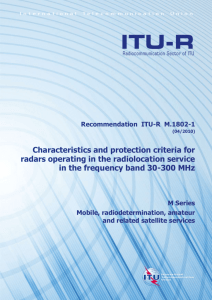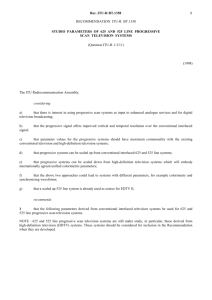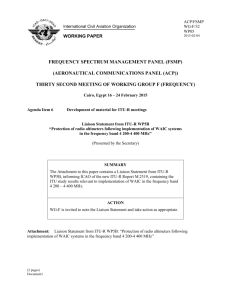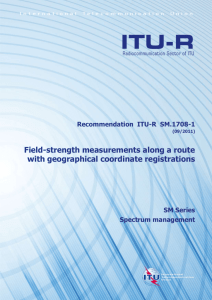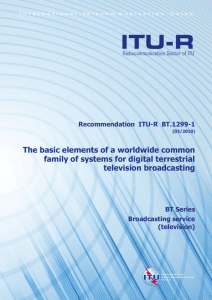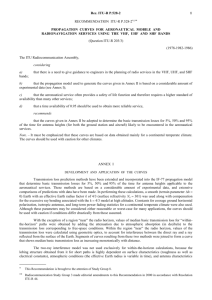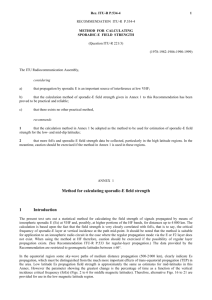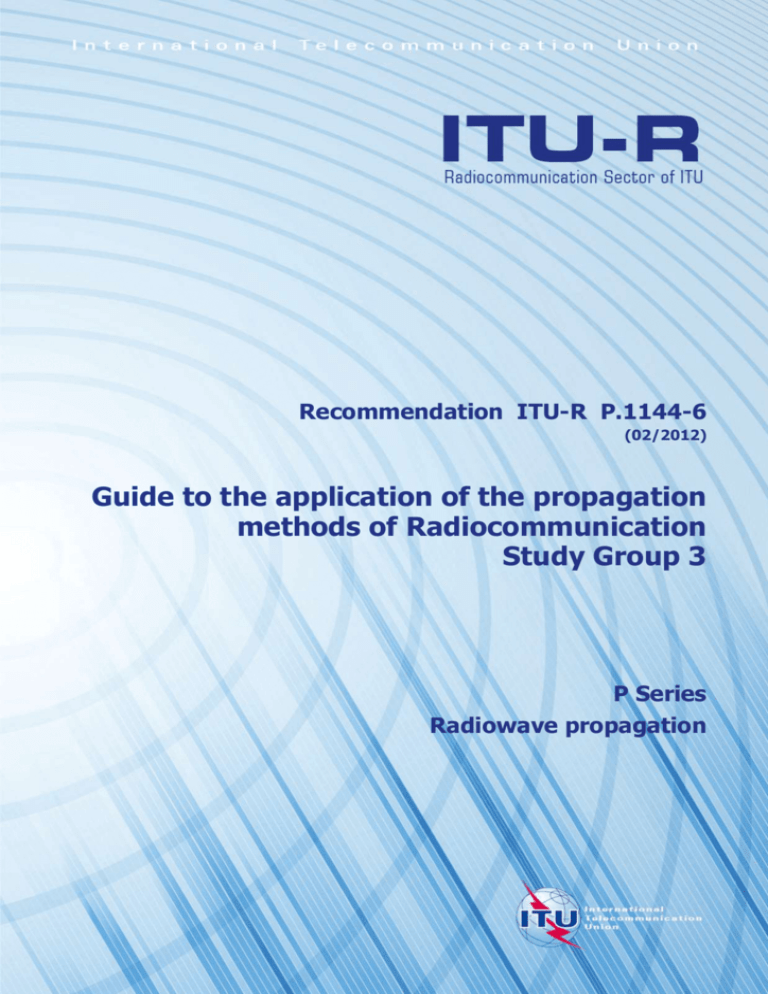
Recommendation ITU-R P.1144-6
(02/2012)
Guide to the application of the propagation
methods of Radiocommunication
Study Group 3
P Series
Radiowave propagation
ii
Rec. ITU-R P.1144-6
Foreword
The role of the Radiocommunication Sector is to ensure the rational, equitable, efficient and economical use of the
radio-frequency spectrum by all radiocommunication services, including satellite services, and carry out studies without
limit of frequency range on the basis of which Recommendations are adopted.
The regulatory and policy functions of the Radiocommunication Sector are performed by World and Regional
Radiocommunication Conferences and Radiocommunication Assemblies supported by Study Groups.
Policy on Intellectual Property Right (IPR)
ITU-R policy on IPR is described in the Common Patent Policy for ITU-T/ITU-R/ISO/IEC referenced in Annex 1 of
Resolution ITU-R 1. Forms to be used for the submission of patent statements and licensing declarations by patent
holders are available from http://www.itu.int/ITU-R/go/patents/en where the Guidelines for Implementation of the
Common Patent Policy for ITU-T/ITU-R/ISO/IEC and the ITU-R patent information database can also be found.
Series of ITU-R Recommendations
(Also available online at http://www.itu.int/publ/R-REC/en)
Series
BO
BR
BS
BT
F
M
P
RA
RS
S
SA
SF
SM
SNG
TF
V
Title
Satellite delivery
Recording for production, archival and play-out; film for television
Broadcasting service (sound)
Broadcasting service (television)
Fixed service
Mobile, radiodetermination, amateur and related satellite services
Radiowave propagation
Radio astronomy
Remote sensing systems
Fixed-satellite service
Space applications and meteorology
Frequency sharing and coordination between fixed-satellite and fixed service systems
Spectrum management
Satellite news gathering
Time signals and frequency standards emissions
Vocabulary and related subjects
Note: This ITU-R Recommendation was approved in English under the procedure detailed in Resolution ITU-R 1.
Electronic Publication
Geneva, 2012
ITU 2012
All rights reserved. No part of this publication may be reproduced, by any means whatsoever, without written permission of ITU.
Rec. ITU-R P.1144-6
1
RECOMMENDATION ITU-R P.1144-6
Guide to the application of the propagation methods
of Radiocommunication Study Group 3
(1995-1999-2001-2001-2007-2009-2012)
Scope
This Recommendation provides a guide to the Recommendations of Radiocommunication Study Group 3
which contain propagation prediction methods. It advises users on the most appropriate methods for
particular applications as well as the limits, required input information, and output for each of these methods.
The ITU Radiocommunication Assembly,
considering
a)
that there is a need to assist users of the ITU-R Recommendations P Series (developed by
Radiocommunication Study Group 3),
recommends
1
that the information contained in Table 1 be used for guidance on the application of the
various propagation methods contained in the ITU-R Recommendations P Series (developed by
Radiocommunication Study Group 3);
2
that the information contained in Table 2 and Annex 1 be used for guidance on the use of
the various digital maps of geophysical parameters necessary for the application of the propagation
methods in recommends 1 above.
NOTE 1 – For each of the ITU-R Recommendations in Table 1, there are associated information columns to
indicate:
Application: the service(s) or application for which the Recommendation is intended.
Type: the situation to which the Recommendation applies, such as point-to-point, point-to-area, line-ofsight, etc.
Output: the output parameter value produced by the method of the Recommendation, such as path loss.
Frequency: the applicable frequency range of the Recommendation.
Distance: the applicable distance range of the Recommendation.
% time: the applicable time percentage values or range of values of the Recommendation; % time is
the percentage of time that the predicted signal is exceeded during an average year.
% location: the applicable per cent location range of the Recommendation; % location is the percentage
of locations within, say, a square with 100 to 200 m sides that the predicted signal is exceeded.
Terminal height: the applicable terminal antenna height range of the Recommendation.
Input data: a list of parameters used by the method of the Recommendation; the list is ordered by the
importance of the parameter and, in some instances, default values may be used.
The information, as shown in Table 1, is already provided in the Recommendations themselves;
however, the Table allows users to quickly scan the capabilities (and limitations) of the
Recommendations without the requirement to search through the text.
2
Rec. ITU-R P.1144-6
TABLE 1
ITU-R radiowave propagation prediction methods
Method
Application
Type
Output
Frequency
Distance
% time
Terminal height
Not applicable
Ground-based
Not applicable
No limits specified,
within the surface layer
of the atmosphere.
(Not suitable for
aeronautical
applications)
Not applicable
H1: 1.5 m to 20 km
H2: 1 to 20 km
Input data
Frequency
Ground conductivity
Path profile data
Frequency
Percentage time
Tx antenna height
Rx antenna height
Latitude and longitude of Tx
Latitude and longitude of Rx
Meteorological data
Distance
Tx height
Frequency
Rx height
Percentage time
Rec. ITU-R P.368
All services
Point-to-point
Field strength
10 kHz to 30 MHz
1 to 10 000 km
Rec. ITU-R P.452
Services
employing
stations on the
surface of the
Earth;
interference
Point-to-point
Path loss
100 MHz to 50 GHz
Not specified but 0.001 to 50
up to and beyond Average year and
the radio horizon worst month
Rec. ITU-R P.528
Aeronautical
mobile
Point-to-area
Path loss
1 to 95
Rec. ITU-R P.530
Line-of-sight
fixed links
Point-to-point
line-of-sight
All percentages of Not applicable
time in clear-air
conditions;
1 to 0.001 in
precipitation
conditions(1)
And worst month
for attenuation
High enough to ensure Distance
specified path clearance Tx height
Frequency
Rx height
Percentage time
Path obstruction data
Climate data
Terrain information
Rec. ITU-R P.533
Broadcasting
Fixed
Mobile
Point-to-point
Path loss
Diversity
improvement
(clear air
conditions)
XPD(2)
Outage
Error
performance
Basic MUF
Sky-wave field
strength
Available
receiver power
Signal-to-noise
ratio
LUF
Circuit reliability
125 MHz to 15.5 GHz 0 to 1 800 km
(for aeronautical
applications
0 km horizontal
distance does not
mean 0 km path
length)
Approximately
Up to 200 km if
150 MHz to
line-of-sight
1 00 GHz
2 to 30 MHz
All percentages
Not applicable
0 to 40 000 km
Not applicable
% location
Not applicable
Latitude and longitude of Tx
Latitude and longitude of Rx
Sunspot number
Month
Time(s) of day
Frequencies
Tx power
Tx antenna type
Rx antenna type
Rec. ITU-R P.1144-6
3
TABLE 1 (continued)
Method
Rec. ITU-R P.534
Application
Type
Output
Frequency
Distance
% time
% location
Terminal height
Input data
Fixed
Mobile
Broadcasting
Trans-horizon
fixed links
Point-to-point
via sporadic E
Field strength
30 to 100 MHz
0 to 4 000 km
0 to 50
Not applicable
Not applicable
Distance
Frequency
Point-to-point
Path loss
30 MHz
100 to 1 000 km
20, 50, 90, 99,
and 99.9
Not applicable
Frequency
Tx antenna gain
Rx antenna gain
Path geometry
Rec. ITU-R P.618
Satellite
Point-to-point
Path loss
Diversity gain
and (for
precipitation
condition) XPD(2)
1 to 55 GHz
Any practical
orbit height
0.001-5 for rain
Not applicable
attenuation;
0.001 – 50 for
total attenuation,
0.001-1 for
XPD(2)
Also worst month
for attenuation
No limits specified
within the surface layer
of the atmosphere.
(Not suitable for
aeronautical
applications)
No limit
Rec. ITU-R P.620
Earth station
frequency
coordination
Coordination
distance
Distance of which 100 MHz to 105 GHz
the required
propagation loss
is achieved
Up to 1 200 km
0.001 to 50
Not applicable
Rec. ITU-R P.679
Broadcast
satellite
Point-to-area
Path loss
Effect of local
environment
0.5 to 5.1 GHz
Any practical
orbit height
Not applicable
No limits
specified
Rec. ITU-R P.680
Maritime
Point-to-point
mobile satellite
0.8-8 GHz
Any practical
orbit height
To 0.001% via
Rice-Nakagami
distribution
Limit of 0.01%
for interference(1)
Not applicable
Rec. ITU-R P.681
Land mobile
satellite
Sea-surface
fading
Fade duration
Interference
(adjacent
satellite)
Path fading
Fade duration
Non-fade
duration
0.8 to 20 GHz
Any practical
orbit height
Not applicable
Percentage of
distance travelled
1 to 80%(1)
Not applicable
No limit
Frequency
Elevation angle
Percentage of distance
travelled
Approximate level of optical
shadowing
Rec. ITU-R P.617
Point-to-point
Meteorological data
Frequency
Elevation angle
Height of earth station
Separation and angle
between earth station sites
(for diversity gain)
Antenna diameter and
efficiency (for scintillation)
Polarization angle (for
XPD(2))
No limits specified
Minimum basic transmission
within the surface layer loss
Frequency
of the atmosphere.
Percentage of time
(Not suitable for
Earth-station elevation angle
aeronautical
applications)
No limits specified
Frequency
Elevation angle
Features of local
environment
No limit
Frequency
Elevation angle
Maximum antenna boresight
gain
4
Rec. ITU-R P.1144-6
TABLE 1 (continued)
Method
Application
Type
Rec. ITU-R P.682
Aeronautical
Point-to-point
mobile satellite
Rec. ITU-R P.684
Fixed
Mobile
Rec. ITU-R P.843
Output
Frequency
Distance
% time
% location
Terminal height
Input data
Frequency
Elevation angle
Polarization
Maximum antenna boresight
gain
Antenna height
Latitude and longitude of Tx
Latitude and longitude of Rx
Distance
Tx power
Frequency
Ground constants
Season
Sunspot number
Hour of day
Frequency
Distance
Tx power
Antenna gains
Latitude and longitude of Tx
Latitude and longitude of Rx
Distance
Sunspot number
Tx power
Frequency
Frequency
Distance
Floor and wall factors
Frequency
Cell size
Terminal heights
Building height statistical
parameters
1 to 2 GHz (seasurface fading)
1 to 3 GHz (multipath
from ground)
Any practical
orbit height
To 0.001% via
Rice-Nakagami
distribution(1)
Not applicable
No limit for sea-surface
fading
Up to 1 km for ground
reflection during
landing
Point-to-point
Point-to-area
Sea-surface
fading
Multipath from
ground and
aircraft during
landing
Sky-wave field
strength
30 to 150 kHz
0 to 16 000 km
50
Not applicable
Not applicable
Fixed
Mobile
Broadcasting
Point-to-point via
meteor-burst
Received power
Burst rate
30 to 100 MHz
100 to 1 000 km
0 to 5
Not applicable
Not applicable
Rec. ITU-R P.1147
Broadcasting
Point-to-area
Sky-wave field
strength
0.15 to 1.7 MHz
50 to 12 000 km
1, 10, 50
Not applicable
Not applicable
Rec. ITU-R P.1238
Mobile
RLAN
Path loss
Delay spread
900 MHz to 100 GHz Within buildings
Not applicable
Not applicable
Base: about 2-3 m
Mobile: about 0.5-3 m
Rec. ITU-R P.1410
Broadband
radio access
In-building
propagation
methods
Point-to-area
Coverage
Temporal
coverage
reduction due to
rain
3 to 60 GHz
0.001 to 1 (for
calculating
reduction in
coverage due to
rain)
Up to 100
No limit; 0-300 m
(typical)
0-5 km
Rec. ITU-R P.1144-6
5
TABLE 1 (continued)
Type
Output
Rec. ITU-R P.1411
Method
Mobile
Application
Short-path
propagation
methods
Path loss
Delay spread
300 MHz to 100 GHz < 1 km
Frequency
Not applicable
Not applicable
Base: about 4-50 m
Mobile: about 0.5-3 m
Rec. ITU-R P.1546
Terrestrial
services
Point-to-area
Field strength
30 to 3 000 MHz
1 to 1 000 km
1 to 50
1 to 99
Tx/base: effective
height from less than
0 m to 3 000 m
Rx/mobile: m
Rec. ITU-R P.1622
Satellite optical Point-to-point
links
Far-field Earthto-space optical
links
Not applicable
Not applicable
No limit
Rec. ITU-R P.1623
Satellite
Point-to-point
Any practical
orbit height
Not applicable
Not applicable
No limit
Rec. ITU-R P.1812
Terrestrial
services
Point-to-area
Field strength
1 to 99
No limits specified,
within the surface layer
of the atmosphere.
(Not suitable for
aeronautical
applications)
Rec. ITU-R P.1814
Terrestrial
optical links
Point-to-point
Absorption loss
20 to 375 THz
Scattering loss
Background noise
Amplitude
scintillation
Beam spreading
Not applicable
No limit
Absorption loss
20 to 375 THz
Scattering loss
Background noise
Amplitude
scintillation
Angle of arrival
Beam wander
Beam spreading
Fade duration,
10 to 50 GHz
fade slope
Distance
% time
30 MHz to 3 000 MHz Not specified but 1 to 50
up to and beyond
the radio horizon
No limit
Not applicable
% location
Terminal height
Input data
Frequency
Distance
Street dimensions
Structure heights
Terrain height and ground
cover (optional)
Path classification
Distance
Tx antenna height
Frequency
Percentage time
Rx antenna height
Terrain clearance angle
Percentage locations
Refractivity gradient
Wavelength
Terminal height
Elevation angle
Turbulence structure
parameter
Frequency
Elevation angle
Attenuation threshold
Filter bandwidth
Path profile data
Frequency
Percentage time
Tx antenna height
Rx antenna height
Latitude and longitude of Tx
Latitude and longitude of Rx
Meteorological data
Wavelength
Visibility (in fog)
Path length
Turbulence structure
parameter
6
Rec. ITU-R P.1144-6
TABLE 1 (end)
Output
Frequency
Rec. ITU-R P.1853
Method
Terrestrial
satellite
Application
Point-to-point
Type
Rain attenuation
for terrestrial
paths
Total attenuation
and tropospheric
scintillation for
Earth-space paths
4 to 40 GHz for
terrestrial paths
4 to 55 GHz for Earthspace paths
Between 2 and
60 km for
terrestrial paths
GEO satellite
Not applicable
Not applicable
No limit
Meteorological data
Frequency
Elevation angle
Height of earth station
Separation and angle
between earth station sites
(for diversity gain)
Antenna diameter and
efficiency (for scintillation)
Rec. ITU-R P.2001
Terrestrial
services
Point-to-point
Path loss
30 MHz to 50 GHz
3 to 1 000 km
0 to 100
Not applicable
No limits specified,
within the troposphere
Path profile data
Frequency
Percentage time
Tx antenna height, gain and
azimuthal direction
Rx antenna height, gain and
azimuthal direction
Latitude and longitude of Tx
Latitude and longitude of Rx
Polarization
(1)
Time percentage of outage; for service availability, subtract value from 100.
(2)
XPD: Cross-polarization discrimination.
Distance
% time
% location
Terminal height
Input data
Rec. ITU-R P.1144-6
7
TABLE 2
ITU-R digital maps of geophysical parameters
Recommendation
ITU-R
Description
Grid resolution
Spatial
interpolation
required
(see Annex 1)
Interpolation in
probability
Interpolation of
the variable
1.5 × 1.5
Bi-linear
Not applicable
Not applicable
ESA0HEIGHT.TXT
File names
P.839
Mean annual 0C isotherm height (km)
(zerodeg)
P.837
Rain rate exceedance probability (%)
(rain rate)
1.125 × 1.125
Bi-linear
Not applicable
Not applicable
ESARAIN_xxx_v5.TXT; xxx = PR6,
BETA, MT
P.1511
Topographic altitude (a.m.s.l.) (km)
(altitude)
0.5 × 0.5
Bi-cubic
Not applicable
Not applicable
TOPO0DOT5.TXT
P.836
Total columnar water vapour exceedance
probability (%) (IWVC)
1.125 × 1.125
Bi-linear(1)
Logarithmic
Linear
ESAWVC_xx_v4.TXT; xx = 01, 02, 03, 05,
1, 2, 3, 5, 10, 20, 30, 50, 60, 70, 80, 90, 95,
99
P.836
Surface water vapour density exceedance
probability (%) (Rho)
1.125 × 1.125
Bi-linear(1)
Logarithmic
Linear
SURF_WV_xx_v4.TXT; xx = 01, 02, 03,
05, 1, 2, 3, 5, 10, 20, 30, 50, 60, 70, 80, 90,
95, 99
P.836
Water vapour scale height
1.125 × 1.125
Bi-linear
Logarithmic
Linear
VSCH_xx_v4.TXT; xx = 01, 02, 03, 05, 1,
2, 3, 5, 10, 20, 30, 50, 60, 70, 80, 90, 95, 99
P.1510
Mean annual surface temperature
(temperature)
1.5 × 1.5
Bi-linear
Not applicable
Not applicable
ESATEMP.TXT
P.453
Median value of the wet term of the
refractivity (Nwet)
1.5 × 1.5
Bi-linear
Not applicable
Not applicable
ESANWET.TXT
P.453
Refractivity gradient in the lowest 65 m
of the atmosphere (N-units/km)
1.5 × 1.5
Bi-linear
Not defined
Not applicable
DNDZ_xx.TXT; xx = 01, 10, 50, 90, 99
P.840
Columnar cloud liquid water exceedance
probability (%) (CLW)
1.125 × 1.125
Bi-linear
Logarithmic
Linear
ESAWREDP_xx_v4.TXT; xx = 01, 02, 03,
05, 1, 2, 3, 5, 10, 20, 30, 50, 60, 70, 80, 90,
95, 99
P.840
Statistical distribution of total cloud
liquid water content
1.125 × 1.125
Bi-linear
Not applicable
Not applicable
WRED_LOGNORMAL_MEAN_v4.TXT,
WRED_LOGNORMAL_STDEV_v4.TXT,
and
WRED_LOGNORMAL_PCLW_v4.TXT
8
Rec. ITU-R P.1144-6
TABLE 2 (end)
Recommendation
ITU-R
Description
Grid resolution
Spatial
interpolation
required
(see Annex 1)
Interpolation in
probability
Interpolation of
the variable
File names
P.617
Troposcatter climate zones
0.5 × 0.5
Not applicable
Not applicable
Not applicable
TropoClim.txt
P.2001
Surface level refractivity and gradient in
the lowest 1 km of the atmosphere
1.5 × 1.5
Bi-linear
Not applicable
Linear
DN_Median.txt
DN_SupSlope.txt
DN_SubSlope.txt
P.2001 and P.534
Critical frequency for sporadic-E (F0Es)
1.5 × 1.5
Bi-linear
Linear
Linear
FoEs50.txt
FoEs10.txt
FoEs01.txt
FoEs0.1.txt
IWVC: integrated water vapour content.
(1)
The variables at the surrounding grid points are scaled to the desired altitude prior to spatial interpolation per the scaling procedure in the applicable
Recommendation.
Rec. ITU-R P.1144-6
9
For easy reference, Fig. 1 shows the relationship between the geophysical maps (black boxes) and
propagation effects (white boxes).
FIGURE 1
Temperature
Rho
IWVC
Dry air
attenuation
CLW
H2O vapour
attenuation
Nwet
Cloud
attenuation
Altitude
Rain Rate
Zerodeg
Rain
attenuation
Scintillation
Annex 1
1
Bi-linear interpolation
FIGURE 2
Row = R + 1
r
Row = R
Column = C
c
Column = C + 1
Given: Values at four surrounding grid points: I(R,C), I(R,C 1), I(R 1,C), and I(R 1,C 1).
Problem: Determine I(r,c), where r is a fractional row number and c is a fractional column number,
using bi-linear interpolation.
10
Rec. ITU-R P.1144-6
Solution: Calculate:
I(r,c)
I(R,C) [(R 1 – r)(C 1 – c)]
I(R 1,C) [(r – R)(C 1 – c)]
I(R,C 1) [(R 1 – r)(c – C)]
I(R 1,C 1) [(r – R)(c – C)]
2
Bi-cubic interpolation
FIGURE 3
Row = R + 3
Row = R + 2
r
Row = R + 1
Row = R
Column = C
Column = C + 1 c
Column = C + 2
Column = C + 3
Given: Values at 16 surrounding grid points:
I(R,C), I(R,C 1), I(R,C 2), I(R,C 3),
I(R 1,C), I(R 1,C 1), I(R 1,C 2), I(R 1,C 3),
I(R 2,C), I(R 2,C 1), I(R 2,C 2), I(R 2,C 3),
I(R 3,C), I(R C 1), I(R 3,C 2), I(R 3,C 3).
Problem: Calculate I(r,c), where r is a fractional row number and c is a fractional column number,
using bi-cubic interpolation.
Solution:
Step 1: For each row, x, where x {r, r 1, r 2, r 3}, compute the interpolated value at the
desired fractional column c as:
RI ( X , c)
C 3
I ( X , j ) K (c j )
j C
Rec. ITU-R P.1144-6
11
where:
(a 2) 3 (a 3) 2 1
3
2
K () a 5a 8a 4a
0
for
for
for
0 1
1 2
2
and
a –0.5
Step 2: Calculate I(r,c) by interpolating the one-dimensional interpolations, RI(R,c), RI(R 1,c),
RI(R 2,c), and RI(R 3,c) in the same manner as the row interpolations.

